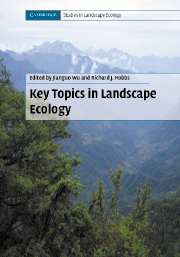Book contents
- Frontmatter
- Contents
- List of contributors
- Preface
- PART I Introduction
- PART II Key topics and perspectives
- 2 Adequate data of known accuracy are critical to advancing the field of landscape ecology
- 3 Landscape pattern analysis: key issues and challenges
- 4 Spatial heterogeneity and ecosystem processes
- 5 Landscape heterogeneity and metapopulation dynamics
- 6 Determining pattern–process relationships in heterogeneous landscapes
- 7 Scale and scaling: a cross-disciplinary perspective
- 8 Optimization of landscape pattern
- 9 Advances in detecting landscape changes at multiple scales: examples from northern Australia
- 10 The preoccupation of landscape research with land use and land cover
- 11 Applying landscape-ecological principles to regional conservation: the WildCountry Project in Australia
- 12 Using landscape ecology to make sense of Australia's last frontier
- 13 Transferring ecological knowledge to landscape planning: a design method for robust corridors
- 14 Integrative landscape research: facts and challenges
- PART III Synthesis
- Index
- References
7 - Scale and scaling: a cross-disciplinary perspective
Published online by Cambridge University Press: 12 January 2010
- Frontmatter
- Contents
- List of contributors
- Preface
- PART I Introduction
- PART II Key topics and perspectives
- 2 Adequate data of known accuracy are critical to advancing the field of landscape ecology
- 3 Landscape pattern analysis: key issues and challenges
- 4 Spatial heterogeneity and ecosystem processes
- 5 Landscape heterogeneity and metapopulation dynamics
- 6 Determining pattern–process relationships in heterogeneous landscapes
- 7 Scale and scaling: a cross-disciplinary perspective
- 8 Optimization of landscape pattern
- 9 Advances in detecting landscape changes at multiple scales: examples from northern Australia
- 10 The preoccupation of landscape research with land use and land cover
- 11 Applying landscape-ecological principles to regional conservation: the WildCountry Project in Australia
- 12 Using landscape ecology to make sense of Australia's last frontier
- 13 Transferring ecological knowledge to landscape planning: a design method for robust corridors
- 14 Integrative landscape research: facts and challenges
- PART III Synthesis
- Index
- References
Summary
Introduction
Scale and heterogeneity are two key concepts in landscape ecology which are inherently related. Scale would matter little in a world where entities and relationships remain invariant across space or time, or in a landscape that is spatially or temporally homogeneous (i.e., uniform or random). However, real landscapes are heterogeneous biophysically and socioeconomically, and they must be treated as such for most questions and problems that interest us as scientists or citizens. Spatial heterogeneity – the diversity of entities and their spatial arrangement – is one of the most essential and unifying features of all natural and anthropogenic systems. Landscape heterogeneity is the manifestation of patchiness (discrete patterns) and gradients (continuous variations) that are intertwined across multiple spatial scales. Thus, scale is indispensable for describing and understanding landscape pattern.
It is not surprising, therefore, that scale has become one of the most fundamental concepts in landscape ecology, a field that focuses prominently on spatial heterogeneity and its ecological consequences (Risser et al. 1984, Forman and Godron 1986, Forman 1995, Turner et al. 2001). In fact, landscape ecology has been widely recognized by biologists, geographers, and even social scientists for its leading role in studying scale issues (McBratney 1998, Marceau 1999, Withers and Meentemeyer 1999, Meadowcroft 2002, Sayre 2005). However, it was not until the 1980s that the notion of scale began to gain its prominence in landscape ecology (and in ecology in general). Also, landscape ecology is not the only discipline that deals with scale and spatial pattern.
- Type
- Chapter
- Information
- Key Topics in Landscape Ecology , pp. 115 - 142Publisher: Cambridge University PressPrint publication year: 2007
References
- 56
- Cited by

